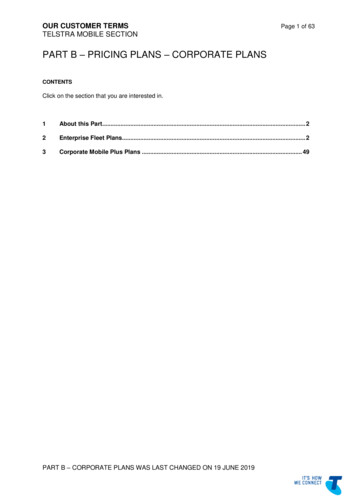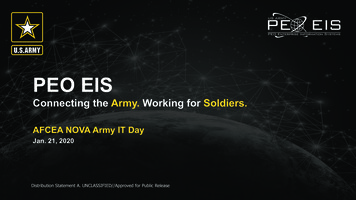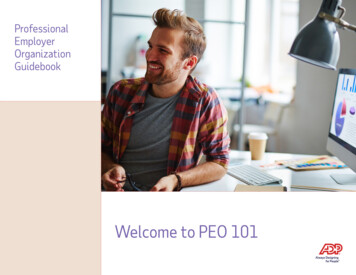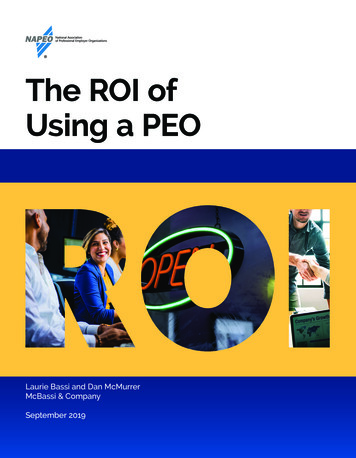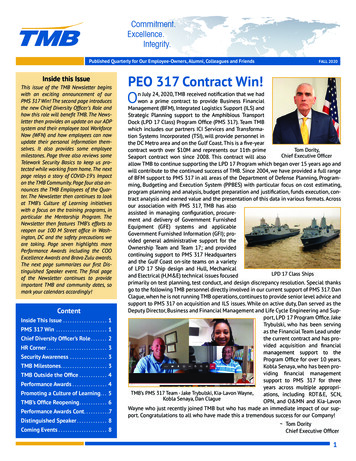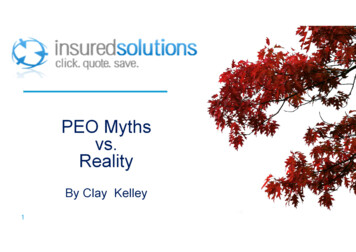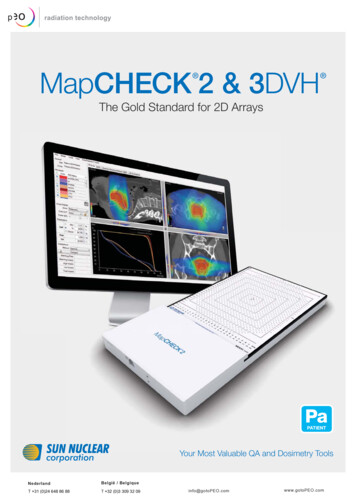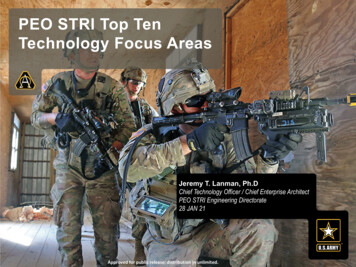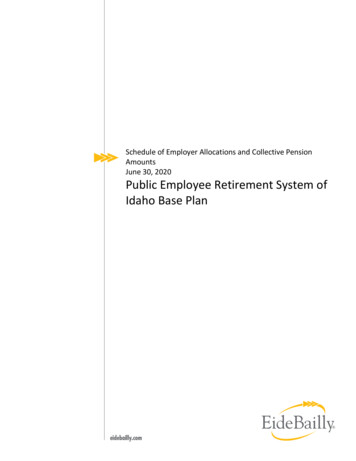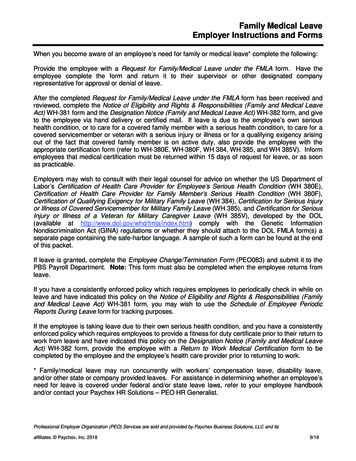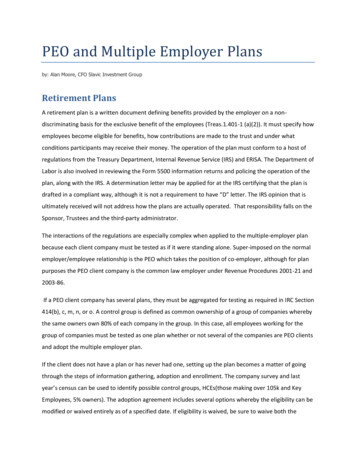
Transcription
PEO and Multiple Employer Plansby: Alan Moore, CFO Slavic Investment GroupRetirement PlansA retirement plan is a written document defining benefits provided by the employer on a nondiscriminating basis for the exclusive benefit of the employees (Treas.1.401-1 (a)(2)). It must specify howemployees become eligible for benefits, how contributions are made to the trust and under whatconditions participants may receive their money. The operation of the plan must conform to a host ofregulations from the Treasury Department, Internal Revenue Service (IRS) and ERISA. The Department ofLabor is also involved in reviewing the Form 5500 information returns and policing the operation of theplan, along with the IRS. A determination letter may be applied for at the IRS certifying that the plan isdrafted in a compliant way, although it is not a requirement to have “D” letter. The IRS opinion that isultimately received will not address how the plans are actually operated. That responsibility falls on theSponsor, Trustees and the third-party administrator.The interactions of the regulations are especially complex when applied to the multiple-employer planbecause each client company must be tested as if it were standing alone. Super-imposed on the normalemployer/employee relationship is the PEO which takes the position of co-employer, although for planpurposes the PEO client company is the common law employer under Revenue Procedures 2001-21 and2003-86.If a PEO client company has several plans, they must be aggregated for testing as required in IRC Section414(b), c, m, n, or o. A control group is defined as common ownership of a group of companies wherebythe same owners own 80% of each company in the group. In this case, all employees working for thegroup of companies must be tested as one plan whether or not several of the companies are PEO clientsand adopt the multiple employer plan.If the client does not have a plan or has never had one, setting up the plan becomes a matter of goingthrough the steps of information gathering, adoption and enrollment. The company survey and lastyear’s census can be used to identify possible control groups, HCEs(those making over 105k and KeyEmployees, 5% owners). The adoption agreement includes several options whereby the eligibility can bemodified or waived entirely as of a specified date. If eligibility is waived, be sure to waive both the
service and age requirement and make sure the client understands that part-time employees employedon the waiver date will be in the plan. NOTE: The waiver could ruin the ability of the HCEs to defer in ameaningful way due to the ADP test. Also, the adoption document allows a limit as to who receives aprofit sharing contribution, if one is declared. By selecting the last-day rule, employees not employed onthe last day of the year don’t receive the contribution. If the last-day rule is not selected, thoseemployees eligible for the plan before their termination must receive the profit sharing. Lastly, do notoverlook the importance of the effective date. Try and use an effective date that corresponds to thedate deferrals will actually begin. This will enable the deferrals to be matched accurately with thecovered compensation and the tests that we perform will be more accurate.The enrollment should include (not counting a waiver) all employees age 21 who have worked for oneyear (at least 1, 000 hours). They may defer up to 85% of their W-2 pay, or 16,000 (in 2008), if they arenot a HCE or Key limited by the ADP test. The 16,000 (IRC 402(g)) maximum amount is limited by theAverage Deferral Percentage (ADP) test. The Average Contribution Percentage (ACP) test is alsoperformed and is the same as the ADP test, but performed on the matching contribution. The PEOactually calculates the match with their system per pay period; Slavic simply tests the match per ACP.The ADP/ACP tests require: 1) the Key and Highly-Compensated employees (HCEs) must be identified; 2)the deferral rates of the Non-Highly-Compensated employees (NHCEs) are averaged together with theeligible non-deferring employees being averaged in as zeros. The HCEs and Keys are only allowed todefer, on average, 2% more than the NHCE average rate. The exception to the rule is if the NHCE rate isless than 2%, then the rate must be multiplied by two (Sec. 401(a)).About 60% of clients choose to match contributions when the advantages are explained. A good matchwill entice the NHCEs to defer more, thereby increasing the allowed rate for the owners and HCEs. Thetax savings on the increased HCE contributions and the fact that the match is subject to a vestingschedule reduces the real out-of-pocket cost of a match. Because the ER funds are not fully vested forsix years, a portion of the match will be forfeited back to the client when employees, who are not fullyvested, terminate. These forfeited funds are then placed into a forfeiture account and used in the firstquarter of the following year as a credit against the match at that time. The procedure is for the trusteeto send a letter with one of the PEO transmittals reading, “take a credit in the amount of xxx for client’sforfeiture account,” thereby reducing the amount of the check that normally adds up to the contributionamount in the electronic file. Slavic does not automatically forfeit the accounts of terminatedparticipants. The trustee or participant may initiate that action.
This brings up several questions to being in a multiple employer plan. First, to be considered terminated,the employee must leave the PEO and the client company and must not work for another clientcompany of the PEO. Otherwise, the employee may not receive a distribution or IRA rollover and noforfeiture of ER money may occur. If the participant begins to work for another client company, his EEand ER balances go with him and he continues to accrue service years and vesting and he is immediatelyeligible for the new employer’s plan. The original employer may not receive any forfeiture until theemployee has terminated from the PEO client company. By this time, the employee may be 100%vested.If the client company leaves the PEO, participants may not receive a distribution or an IRA rolloveroption while they are still employed at the worksite and they would become automatically 100% vested(Sec. 401(k)(2)(b), 408k), unless a successor plan is setup within 90 days. To receive the assets out of theplan, the employer must establish another qualified 401(k) plan with the client as the trustee. That planmay be terminated and distributions made if the client does not set-up or adopt a “successor” pensionplan for one year (Treas. Reg. 1.401(k)-(1)(d)(3)). The client should consult their attorney if any plan is tobe terminated.“Profit sharing” is also included as another way of contributing to the plan and is also subject tovesting. A profit sharing contribution is discretionary and employer funded using a formula such as 6% ofW-2 pay. As with the match, this ER source is not subject to FICA tax as the EE deferral is. It is differentfrom the match in that it must be contributed to all eligible employees whether or not they defer to theplan. A 3% profit sharing contribution to non-Key employees is required if the plan is top-heavy. TheBoard of Directors should declare the profit sharing at year-end and employer has until the filing date ofthe 1120 tax return to fund it. In this instance, the client would send a check directly to the plan trustaccount at Depository Services (DSI) with an accounting. The accounting is necessary because profitsharing is not typically funded through the PEO payroll. As mentioned before, the adoption agreementincludes the option of the “last-day rule” for eligibility to receive profit sharing. This means only theemployees employed as of 12/31 will receive the contribution. Most employers desire this selectiononce it has been explained to them; however this option is not available for Safe Harbor Plans.As you can see, the multiple employer plan allows wide latitude for contributions to be made to thetrust. The trust is the legal entity that holds the funds on behalf of the participants. Only the trusteesmay authorize distributions from the trust. The trustees have hired Slavic Integrated Administration(SIA) to act as the third-party administrator (TPA) in charge of processing and accounting for
contributions, distributions and tax filings. Slavic Mutual Fund Management Corporation (SMF), anaffiliate of SIA, has been appointed as the Advisor to the plan, providing investment advice to theparticipants and monitoring the fund platform. Slavic Investment Corporation (SIC) is the broker/dealermaking the actual transactions at the fund company level. Thus, the plan has a one-source provider forthe full range of services needed to run a successful 401(k) plan.It is the TPA’s job to perform the ADP and ACP tests along with a number of other testes important tothe plan. One of those tests is the top-heavy test. After the first year, a plan is deemed to be top-heavyin the year following the current year’s 12/31 valuation if the Key employees (Treas. Reg. 1.416) own60% or more of the assets in the trust at the client level. A Key employee is an employee who ownsmore than 5% of the business, their spouses and lineal relatives, a shareholder owning 1% of companystock and earning over 150,000 per year and corporate officers who earn over 140,000 per year. Evenif a Key employee sells their stock, they will be considered a Key in the year of the sale and the followingyear. This is especially important when mergers and acquisitions occur. Key employees and HCEs in theacquired company remain so as employees of the acquirer for a period of time. If the merged oracquired company also had a plan, the Key employee’s balances would be added to the acquiringcompany’s plan balances for the top-heavy test (Rev. Proc. 93-42, Sec. 414). In addition, inservice distributions made within five years are added back for the top-heavy determination. Accountingfor this activity is very difficult because clients rarely have the necessary information.If a plan is found to be top-heavy in the first year (Treas. Reg. 1.416) a top-heavy penalty will be requiredbased on the payroll from the plan effective date of the eligible non-Key employees, regardless of whenthey became eligible. After the first year, the plan is considered top-heavy in the year after it fails thetest. The normal 3% profit sharing contribution required for non-Key employees may not need to be thatmuch if, individually, all of the Key employees received contributions equal to less than 3% of theirpay. For example, if no Key employees had any money placed in the plan in the top-heavy year, no profitsharing penalty would be required. If the highest Key employee received 2% from EE and ER resources,then 2% would be the amount of profit sharing required to be made to all non-Keyemployees. Therefore, the client can avoid any top-heavy penalties as long as Key employees do notparticipate.Interim testing will not guarantee that top-heavy plans will be discovered and so it is not done. Newemployees become eligible in the last quarter, year-end bonuses are paid, and deferral rates change allthe time. It is difficult to keep up with these changes considering that the payroll data is transferred a
month after it occurs. The best way to insure against a plan becoming top-heavy is to look at the firstdeferral and gage whether more than 60% of the contributions belong to the Key employees. Butbecause a Key employee related rollover may be rolled in or changes in deferrals may occur in the lastquarter, there is no guarantee. Slavic will run the test as of 12/31 and the client may make changes inthe following year to mitigate the penalty. However, new plans do not have that luxury. Because newplans that are top-heavy in the first year are also considered top-heavy in the second year,automatically, the initial deferral set-up is important. This is another reason administration is required toinclude a census in the start-up package.If a plan is deemed top-heavy, the PEO must convey that information to the client immediately. Thepenalty must be paid before the tax return is filed in order to receive a deduction in the top-heavyyear. The penalty may be funded as late as September 15th if the client extends the 1120 taxreturn. Payment is mandatory in order for the plan to remain in compliance.Below is a summary of the more important tests that are routinely performed:Slavic does not aggregate other plans outside of the PEO plan.1. ADP for the deferrals, max pay used is 225,0002. ACP for the match, max pay used is 225,0003. Top-heavy, Key employees have 60% of assets4. 16,000 deferral5. 415 limit of 46,000 plus 5000 catchup6. 25% deduction limit per employer7. 410B 70% discrimination test8. Eligibility of participantsThe quality of the date is the determining factor as to how accurate the tests will be. SIA is dependenton the file downloads from the PEO and client updates on changes in ownership for the necessaryinformation. Because the match and profit sharing formulas are discretionary, SIA does not verify or testthese. The ACP test is applied to the total match in the plan and does not determine whether theformula was correctly applied. That is the responsibility of the PEO payroll system and the clientcompany. It is important that the client does not start a match that is anything other than a pro rata
percentage of pay for all employees. Varying the match for different groups of employees complicatesthe 410B test and SIA would not have the necessary information to determine that.Participants may receive their benefits or money from the plan in several ways. The typical way torequest a taxable distribution without a penalty is to retire or reach age 59½. Disability, death ortermination of employment are other permissible means of receiving a taxable distribution, however,terminated employees under the age of 59½ are subject to a 10% penalty. Anyone who has a balancegreater than 5,000 may leave their funds in the plan until age 70½; then, if not working, they must takeminimum distributions or receive a 50% penalty. (Sub S owners still working must take a distribution atage 70½.)While a participant is under the age of 59½ and working, the only way to receive money out of the planis to take a hardship (except in the case of disability or death). In this context, working means employedby either the PEO or the worksite employer. Participants may borrow up to 50% of their vested balance(Sec. 72p). Once the loan provision has been maxed out, a hardship (tax and 10% penalty due) may betaken for the EE balance only (no earnings). Loans should be considered a last resort because of the waythe IRS taxes a default. If a quarter’s payment is missed, a 1099 will be generated in the amount of theunpaid balance and income tax and penalty will be due. In addition, the participant must still pay backthe loan if under age 59½.After taking a hardship distribution, the participant is barred from deferring to the plan for a period ofsix months. Upon resuming deferrals, the current year deferral limit of 16,000 is reduced by thedeferrals made in the year the hardship was taken.If a termination occurs, balances may also be rolled to an IRA or another qualified 401(k) plan, tax–free.Simple IRA plans cannot be rolled into a 401(k) plan.Taking money out of a retirement plan is a cumbersome process. Because of this, make sure the client isa valid 401(k) candidate before advising them to adopt. As a rule of thumb, if there are five or feweremployees who wish to defer 4,000 each, do not set-up a 401(k) plan unless the employer is making asignificant match. One alternative you might offer to a qualified pension plan is the IRA (Sec. 408). A401(k) plan is expensive to maintain and more difficult to take money out of when compared toindividual IRAs.
There are two types of IRAs to select from: the “Roth” and the “Regular”. Roth IRAs have limits thatemployees must be made aware of. In order for a married couple to contribute to a Roth IRA, they musthave an adjusted gross income between 150,000 and 160,000 and jointly under 100,000 to convert aRegular IRA to a Roth. Roth IRA contributors may also participate in a 401(k) plan (subject to incomelimits). However, those who contribute to a Regular IRA may not contribute to a 401(k) if, as a couple,they earn 75,000 or more or, as an individual, earn 55,000 or more. However, if married, the spousewho is not contributing to a 401(k) may contribute 4,000 to a Regular IRA without regard to thoselimits.The question then becomes which IRA an employee should choose. The Roth IRA is better in the longrun (over 10 years) because distributions are tax-free. Because retirement is usually a long-termobjective, the Regular IRA is less important and has several drawbacks. First, you must begin takingdistributions at age 70½. Secondly, at death it becomes subject to estate and income taxes. The onlytime that a Regular IRA would be advisable is if the client is in a high tax bracket and is close toretirement (age 60 or older). Then, the tax deduction for the contribution becomes a significantadvantage over the nondeductible Roth contribution, an advantage that may not be made up by growthof the fund before distributions would start.Therefore, the Roth IRA will be a strategic tool for HCE/Key participants in a 401(k) plan when they arelimited by the ADP test. The Payroll-Deducted IRA is offered on an after-tax basis with four major fundcompanies. Any of the B-share funds (back-end loaded) at the fund company selected are available. Thetax deduction for the Regular IRA contribution may be taken when the individual’s 1040 tax return isfiled.The Safe Harbor provisions may be available to clients if the PEO amends the master plan to allow forthem. The Summary Plan Description (SPD) of that client should also be amended and distributed by theemployer. Once the PEO formally adopts the Safe Harbor option, a client may adopt and agree to it bychoosing to a use the 100% vested 3% profit sharing or a 4% match (max of 6%), thereby allowing theHCEs to defer up to 16,000 without limitation by the ADP test. This higher deferral allowance may causethe plan to become top-heavy, but a safe harbor plan is exempt from top heavy penalties. The clientshould carefully consider the impact of adopting Safe Harbor. Whatever option is adopted, it must becommunicated to the employees 60 days prior to the effective date and it must be completed beforethe beginning of the plan year. The notice should clearly state which employer contribution has beenadopted.
Taking over client plans or changing investment platforms:There is a fee associated with merging a clients plan into the PEO plan. Whenever this subject comes up,the client should be referred to the Merger Department of Slavic for guidance. Under no circumstancesshould anyone other than out Merger Department tell a client to liquidate balances in another plan andsend it to Slavic or Depository Services. The process includes a due diligence check on the source of themoney and it will be rejected without that approval.When a liquidation occurs, the funds are usually held out of the market for one to three weeks as thetransfer is made and an accounting is reconciled. This means Slavic must depend on outside vendors forinformation and they all work on different schedules. Therefore, Slavic processes these transfers on abest efforts basis. The 30 day notice explains the transfer process to work-site employees.Summary Plan Descriptions:Usually the attorney who drafted the plan provides the SPD on disk. The PEO is responsible fordistributing the SPD to each participant within 30 days. Whenever a new client adopts, the SPD shouldbe changed to reflect what was adopted: i.e., the safe harbor election, eligibil
employer/employee relationship is the PEO which takes the position of co-employer, although for plan purposes the PEO client company is the common law employer under Revenue Procedures 2001-21 and 2003-86. If a PEO client company has several plans, they must be aggregated for

